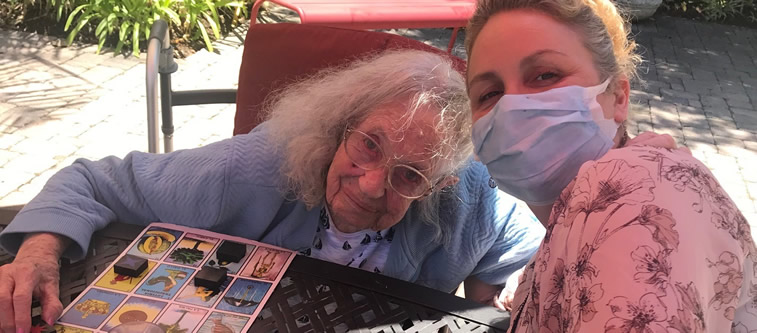By Luciana Mitzkun Weston,
Memory Care Specialist
Villa Alamar Community Services Director
Throughout 2020 the COVID-19 pandemic has generated a health care emergency affecting every community around the globe, forcing us all to change the way we live, including learning and practicing social distance, wearing masks, frequent hand washing, meeting through FaceTime or Zoom calls, and working from home. Adhering to some of these new protocols can potentially be a matter of life-and-death at an individual level. Collectively, it is a matter of stopping the spread of the coronavirus, the virus that causes COVID-19.
Prevention strategies are of particular importance to older adults and those living with pre-existing chronic health conditions. Many of those most vulnerable to complications of COVID-19 are patients with Alzheimer’s disease and other forms of dementia. Their caregivers often struggle with the question: How do I explain COVID to my loved one with dementia?
In the world of memory care, DARE is used as an acronym for Do not Argue, Reason, or Explain. DARE is the Golden Rule for dementia caregivers who learn very quickly from their caregiving experiences that arguing with a loved one with cognitive impairment only results in increased petulance and resistance to care; reasoning is a frustrating exercise in futility; and explaining involves a tremendous amount of energy and invariably begets repeated explanations without ever resulting in comprehension.
In practical terms, it is nearly impossible for dementia patients to fully comprehend why it is necessary to cover one’s face with a mask that is uncomfortable, hot, and restricts breathing. They won’t get why you are wearing one either, and will repeatedly ask you to remove it. They don’t understand that hugging is no longer socially acceptable or why they should stay several feet apart, and will continuously move closer and touch others. Their social programs and outlets have been discontinued, and they are having a hard time connecting with the faces on the zoom screen. They feel lonely and cannot comprehend why their friends and families no longer visit them. And frankly, we are all having a hard time wrapping our heads around all these changes!
Yet, it is our obligation as caregivers to protect our loved ones and to maximize their adherence to the most current preventative strategies.
Before attempting to break the Golden Rule, DARE, by trying to explain to a dementia patient the way things are, there are three aspects of living with dementia we should keep in mind. Consider: (1) Dementia patients live in a world of fear, their biggest being fear of abandonment. Adding COVID-19 and the worldwide confusion regarding its spread to their existing fears can cause them great emotional distress. (2) When cognition is impaired, the importance of touch is paramount. Social distance may be interpreted as personal rejection. (3) Your primary objective is not to impart the understanding of exactly what is happening in regards to the pandemic, but rather to solicit the patient’s adherence to the appropriate preventative strategies.
Don’t explain. When taking these aspects into consideration, it becomes clear that explaining the pandemic is unnecessary—and may even be detrimental—when it comes to a person with dementia. Instead of providing elaborate explanations of something we don’t even fully understand ourselves (new information is released almost daily), here are some better ways of promoting emotional reassurance and compliance with safety strategies for your loved ones during the pandemic:
- As an alternative to COVID-19, use the term FLU
In most cases, dementia causes a progressive loss of cognitive abilities that slowly increases over the years. At some point in this progression, the patient loses the ability to learn new information (what caregivers often attribute to problems with short-term memory). For those whose dementia has crossed this point, learning information about a new disease can be very challenging. If it is necessary to mention the pandemic, you may want to refer to COVID-19 simply as a flu. Most people are familiar with the concept of influenza, which, just like COVID-19, is caused by a virus that is passed through the air from one person to another. Using this term may impart enough information to justify some of the precautionary measures we now use. We are in flu-season sounds far less scary than the bigger picture of a pandemic and will not add too much to the world of fear in which dementia patients generally dwell. - Create a coronavirus-free bubble around your home
Picture your home in a bubble. Inside the bubble you and your loved ones live a full life, free of coronavirus. All you need to do is prevent the coronavirus from entering your bubble from the outside.
Coronavirus may be brought in from the outside by you or other members of the household. When stepping outside, practice all the appropriate preventative strategies (well-fitting masks, social distancing, etc.) Avoid crowds. Thoroughly wash your hands and disinfect your masks as you arrive home from outside your bubble. Insist on and verify that all members of the household do the same.
Coronavirus may also be brought in by visitors. These include friends and family members, but also workers such as repairmen and window washers. Avoid receiving non-essential visitors. If necessary, receive no more than two visitors at a time. Screen all visitors for signs of COVID-19 (temperature higher than 100, headache, fatigue, cough, shortness of breath or difficulty breathing, muscle or body aches, sore throat, nausea or vomiting, diarrhea). Don’t be embarrassed to take their temperature (touchless thermometers are great for that) and to ask all the questions about possible symptoms: You have a vulnerable adult in the household who needs your protection; your visitors will understand. Have your visitors wash their hands as they arrive and have everyone wearing masks and practicing social distancing for the duration of the visit. If possible, visit outside (porch, patio, or backyard). - Social distancing
Having your home in a coronavirus-free bubble means that those living inside can ignore social distancing and enjoy togetherness. Hugging, holding hands, touching, sitting side-by-side on the couch while watching a movie: These are some expressions of affection that are very important for dementia patients, especially as their ability to express themselves in words and gestures become impaired. If your bubble is well maintained and protected, do share these expressions of affection freely at home.
However, when out of the home, social distancing is required. This may be a challenge for your loved one with dementia when accompanying you to a necessary errand, as in shopping for groceries or picking up a prescription at the drugstore. You know your loved one better than anyone else: Can he maintain social distance? If he can, do bring him with you, by all means─he will enjoy the outing. If you are unsure, leave him at home with a companion or a helper. The last thing you want to do is to shame and humiliate him in public by repeatedly calling his attention to respect social distance and step away from others. (You do not have a helper? Contact your local office of the Alzheimer’s Association and ask for respite options). - Use matching masks, make it fun
Masks can be made in a variety of patterns and designs. Find one that matches your loved one’s likes, such as those that depict flowers, kitties, favorite football team, flag, or classic cars. Offer options: Do you want to wear the one with an eagle or the one with a bear today? And wear a themed mask yourself, so wearing masks is seen as a little game between the two of you. Include other family members in the fun, whenever possible.
Also, watch for comfort and proper fit. Ill-fitting masks may cause cuts, abrasions, or excessive pressure on the face and around the ears, and your loved one may not be able to report it. Visually inspect the mask for a comfortable fit. Make sure it covers the nose and has a close fit around the cheeks. - Establish routines
Wash your hands immediately as you arrive home after every outing. Wash your hands together frequently and model proper hand washing. Post reminders on a white board, so your loved one can be prompted to wash his hands on his own. - Avoid crowds and find ways to enjoy the outdoors
We now know that being outdoors is safe, as long as you avoid crowds and wear a mask. People with dementia benefit tremendously from being outdoors, if not for the physical activity just for the opportunity of looking at trees and being in nature. Always avoid crowds, but look for safe opportunities to take your loved one outdoors: Take regular walks, visit a park, or share a meal in a car parked facing a scenic area such as the beach, a lake, or a garden. - Give plenty of compliments
Make your loved one feel good about wearing a mask and maintaining social distance. Compliment on their stylish looks and positive attitude, and let them know that they are loved and appreciated. - Listen to their concerns
Don’t assume how she might be feeling. Ask; listen to their concerns and allow them to express themselves. You may be surprised by some of their comments and by how uniquely they are affected by all the changes we now live with. Their perspective may bring clarity and humor into your own outlook. Use this opportunity to assuage any anxieties they may have. - Write uplifting messages in cards
A great way to communicate with those with dementia is through the written word, since cards and messages can be read repeatedly and provide continuous reassurance. Have family members send cards as well, posting them where they can easily be revisited. Encourage your loved one to write messages back. This is a great activity to do indoors, stimulating creativity. - Make window visits count
For those who are in assisted living and living under lockdown, or for those at home who wish to visit with family and friends who are not part of the household, window visits may be appropriate. Prepare the window space in advance with comfortable sitting both in and outdoors. You can use a cell phone on speaker-mode to facilitate the conversation, so that the parties don’t have to shout through the glass. Bring a picture to share and talk about. And why not make it a party? Bring treats to share and eat together, although apart. - Project confidence and positivity
These are times of great social anxiety and wide-spread instability. We are all concerned about the present and uncertain about the future. Dementia patients are experts in reading between the lines and picking up on your moods and feelings. When with them, it is important to take a break from all the negativity and behave as if under a positive light, so that our fears and concerns are not transmitted to them. This will shield them from fears and anxieties they cannot mitigate. This will also, maybe, give you a respite from your own concerns and help you stay in the moment and better enjoy your own day.
Health experts are now saying that we may not go back to normal until late 2021. Whatever the “normal” to which they are referring will be, clearly our lives will never be the same again. Like everything else, dementia care will adapt. As long as we keep in mind that this is a disease of emotions, not logic, we will succeed in providing quality care to our loved ones. Attend to your loved ones’ requirements for safety and comfort, never overlooking their primary needs for love, companionship, and emotional reassurance. Do the same for yourself, and we will make it through this crisis.

